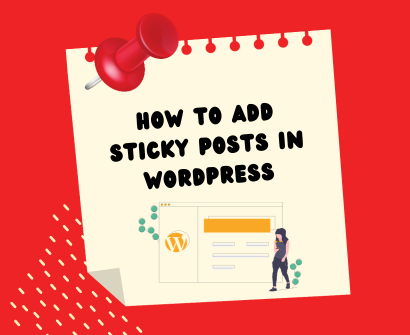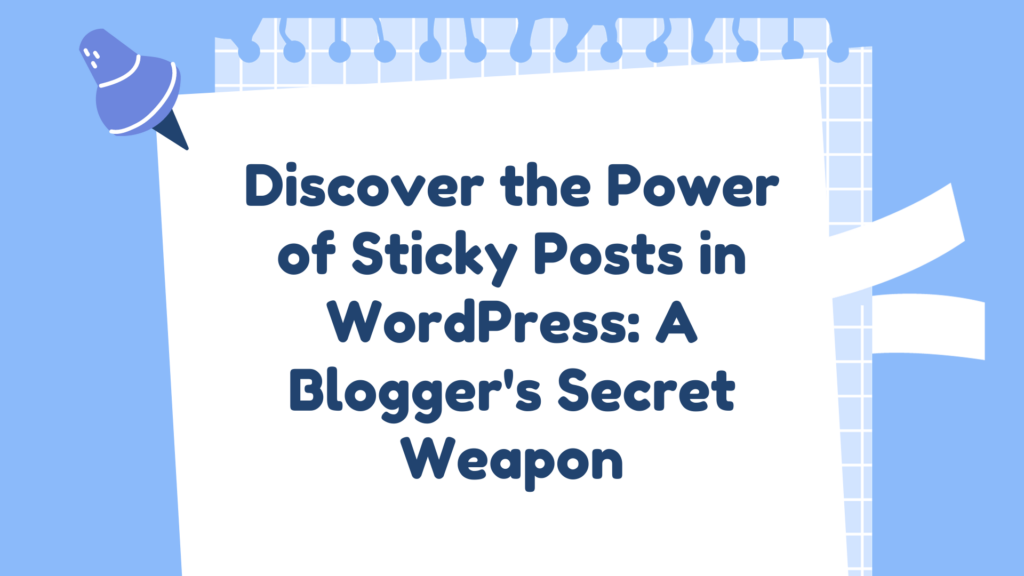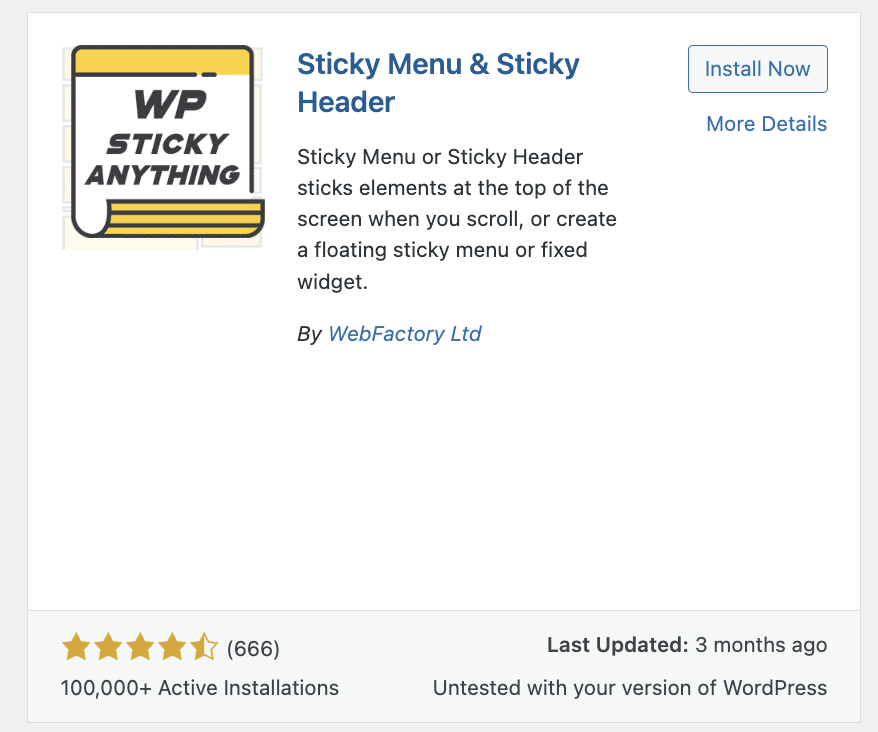

In the dynamic world of blogging, standing out and engaging your audience is key. Enter the world of sticky posts in WordPress – a powerful yet often underutilized feature that can transform the way you highlight your most important content. Imagine having the ability to pin your best articles at the top of your blog, ensuring they receive the attention they deserve.
This is the magic of sticky posts! They are not just a tool, but a game-changer for bloggers aiming to showcase their key content effectively. Beyond mere visibility, sticky posts are incredibly user-friendly, allowing even beginners to enhance their site’s appeal with just a few clicks. But the benefits don’t stop there. Utilizing sticky posts can significantly boost reader engagement and increase site traffic, making it a strategy that you can’t afford to overlook. Let’s dive into how you can harness the full potential of sticky posts to elevate your WordPress site to new heights!
Understanding Sticky Posts
The concept of “sticky posts” is integral, especially for WordPress users. So, what exactly are WordPress sticky posts, and how do they differ from regular posts?
A sticky post in WordPress is a feature that allows bloggers to “pin” a chosen post to the top of their blog’s front page. This means that regardless of how many new posts are published afterward, the sticky post remains prominently displayed at the top.
This differs significantly from regular posts, which are typically arranged in reverse chronological order, with the most recent post appearing first. As new posts are added, older ones get pushed down the page, which can sometimes cause important content to get lost in the shuffle.
The benefits of using sticky posts are substantial when it comes to engaging website visitors. By keeping a crucial post in a prominent position, you ensure it gains maximum visibility. This can be particularly useful for several purposes:
- Highlighting featured content such as important announcements, welcome messages, or key articles.
- Promoting events, special offers, or timely news that you want all visitors to see.
- Enhancing navigation by directing visitors to other sections of the site or to specific content.
By effectively utilizing WordPress sticky posts, you can maintain a strategic grip on how your content is presented and consumed. This not only improves the user experience but also ensures that critical information is not overlooked. Sticky posts are an essential tool in the arsenal of effective blog content management, offering a simple yet powerful way to keep your most important content visible and engaging to your website visitors.
How to Make a Post Sticky in WordPress
Making a post sticky in WordPress is a straightforward process that can greatly enhance the visibility of your key content. Here’s a simple, step-by-step guide to making posts sticky, using the WordPress post editor and visibility settings:
- Access the WordPress Dashboard: Start by logging into your WordPress site and accessing the dashboard. This is your control center for all things WordPress.
- Navigate to the Post Editor: On your dashboard, find and click on the ‘Posts’ section. Here, you’ll see a list of all your blog posts. Choose the post you want to make sticky. If it’s a new post, click on ‘Add New’ to create one. For an existing post, hover over the post title and click ‘Edit.’
- Select ‘Stick to the top of the blog’: In the expanded visibility settings, you’ll find a checkbox labeled ‘Stick to the top of the blog.’ Check this box to make your post sticky.
- Save or Update Your Post: After selecting the sticky option, click ‘OK’ to close the visibility options, and then click ‘Publish’ (for a new post) or ‘Update’ (for an existing post) to apply the changes.
By following these steps, you’ve successfully made your post sticky in WordPress. This post will now appear at the top of your blog page, regardless of the date it was published, ensuring it gets the attention it deserves. Remember, making posts sticky is an effective tool in your WordPress post editor, allowing you to manage the visibility of your key content effectively.

Best Practices for Using Sticky Posts
When it comes to leveraging the full potential of sticky posts in WordPress, there are several best practices to keep in mind. These tips ensure that your use of sticky posts not only enhances your content strategy but also maximizes reader engagement.
- Choose the Right Content to Highlight: The decision of what content to make sticky should be strategic. Ideal candidates for sticky posts are those that offer significant value to your readers. This could be your most popular or recent content, important announcements, special promotions, or timeless resources. Ask yourself, “What do I want every visitor to my site to see first?”
- Regularly Update Your Sticky Posts: To keep your site fresh and engaging, it’s crucial to regularly review and update your sticky posts. Content that is outdated or no longer relevant can be counterproductive, as it may give visitors the impression that your site is not being actively maintained. Set a reminder to check your sticky posts periodically and update them as needed.
- Avoid Overusing Sticky Posts: While sticky posts are a powerful tool, overusing them can lead to a cluttered and overwhelming website. Having too many sticky posts can push your newer content down, making it harder for visitors to see your latest posts. A good rule of thumb is to have no more than two to three sticky posts at any given time.
- Integrate Sticky Posts into Your Overall Content Strategy: Sticky posts should be a part of a larger content strategy aimed at engaging and retaining visitors. Use them to complement other content on your site, guide visitors to other sections, or highlight a series of posts (like a blog series or a product launch).
- Pay Attention to Reader Engagement: Monitor how your sticky posts are performing in terms of reader engagement. Use tools like Google Analytics to track page views, time spent on the page, and bounce rates. This data can provide valuable insights into what content resonates with your audience and can guide future decisions on what to feature as a sticky post.
- Keep SEO in Mind: While your primary goal with sticky posts is to engage visitors, don’t forget about search engine optimization. Ensure that your sticky posts are optimized with relevant keywords, meta descriptions, and engaging titles. This not only helps in attracting more traffic but also in maintaining the SEO health of your website.
Advanced Tips and Tricks for Mastering Sticky Posts in WordPress
Delving deeper into the realm of WordPress sticky posts, there are several advanced techniques and tools that can elevate your blogging experience. From customizing the appearance of sticky posts to utilizing plugins for added functionality, these insights can significantly enhance the impact of your sticky posts.
- Customizing the Appearance of Sticky Posts: One of the key ways to make your sticky posts stand out is by customizing their appearance. This can be done through CSS (Cascading Style Sheets). For instance, you can change the background color, alter the font style, or add a distinctive border to differentiate sticky posts from regular ones. To do this, you’ll need to add custom CSS code to your WordPress theme, targeting the ‘.sticky’ class, which is automatically assigned to all sticky posts.
- Utilizing Plugins for Enhanced Functionality: While WordPress offers basic sticky post functionality, plugins can take this a step further. There are several plugins available that provide additional control and features for managing sticky posts.-
- WP Sticky: This plugin allows you to make any post or page sticky. What sets it apart is its ability to stick more than just posts — you can also stick sections of pages or widgets, giving you unparalleled flexibility.

- Incorporating Sticky Posts in Sidebar Widgets: Another advanced technique is using sticky posts within sidebar widgets. This can be achieved through custom coding or by using certain widgets that allow the display of posts. By doing this, you can keep your sticky content visible even as visitors navigate to different parts of your site.
- Leveraging Analytics to Track Performance: Advanced users can also leverage analytics to track the performance of their sticky posts. By analyzing metrics such as click-through rates, time spent on the post, and engagement levels, you can gain insights into the effectiveness of your sticky posts and make data-driven decisions.
Summary
The strategic use of sticky posts in WordPress is a powerful tool for any blogger looking to enhance their site’s engagement and visibility. By effectively utilizing this feature, you can ensure that your most valuable content remains in the spotlight, capturing the attention of your audience the moment they land on your page.
Sticky posts are more than just a convenient feature; they are a vital component of a successful content strategy. They provide a unique opportunity to showcase your best work, highlight important announcements, or guide visitors to key areas of your site. Whether you’re a seasoned blogger or just starting out, integrating sticky posts into your WordPress site can make a significant difference in how your content is perceived and consumed.
We encourage you to experiment with sticky posts. Start by highlighting a piece of content that represents the best of what your blog offers. Remember the best practices discussed: choose the right content, update regularly, and avoid overuse. Consider exploring advanced techniques like customizing the appearance of your sticky posts or using plugins to add even more functionality.
The beauty of WordPress is its flexibility and ease of use, making it possible for anyone to create a dynamic and engaging website. By leveraging the power of sticky posts, you’re not just organizing your content more effectively; you’re also creating a more captivating and user-friendly experience for your visitors. So, dive in, explore the possibilities, and watch as your blog reaches new heights of engagement and visibility!
